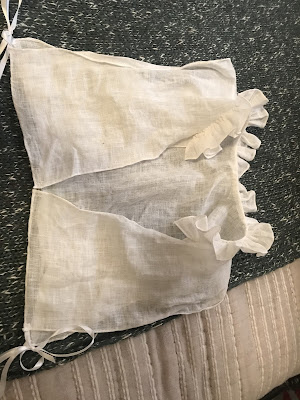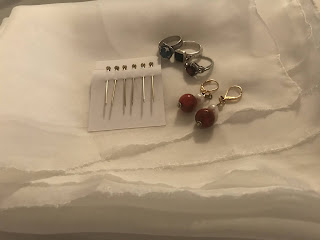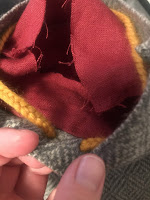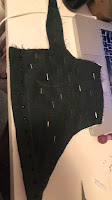
Sometimes I think I'll make something for myself that isn't from mid 16th century Venice. Something Florentine, or from one of the other Italian city-states, or perhaps even *
gasp* something from across the Alps. Well, this is not that time. I'm still in Venice, using fabric I bought to make a Florentine style dress from about a decade earlier... I guess I just really love Venetian style?
I bought this nice lightweight black wool sateen this spring after much obsessing about whether it was really an accurate fabric for this period. I love the subtle black on black stripes, since they add interest without being too busy like some brocades. It's wool, so I worry less about it than silk, and it was a really great price! it looks right to me, but could I be being influenced by pop culture? It's not something you really see in the portraits of the wealthy... So I re-read the section on materials in Tudor Tailor, and found that both wool sateen and tone-on-tone stripes were a thing in the 16th century, so I went ahead and bought enough of this fabric to make myself a gown and a doublet. And while this dress definitely isn't on the same level as the expensive silks seen in portraits of the noble class, it's a nice middle or merchant class look, and certainly a step up from linen or plain wool garb. Plus while I was working on the dress, I found a few portraits that clearly are striped fabric, rather than applied trim, from mid 16th century Italy, so that's exciting:


The first painting is by Sofonisba Anguissola, of some of her younger siblings, which makes the subjects from Cremona, sometime between 1570 and 1590. I love how annoyed her younger sister looks at having to model! I also love that the girls' dresses appear to be tone on tone stripes, probably in wool, but with applied trim. The second is by Giovanni Antonio Fasolo, a Venetian active in northeastern Italy, and probably dates from the 1560s. This puts some lovely stripey dresses at exactly the right time and place for me, though they are on children in both paintings. Still, they're stripes in mid century northern Italy, so it's something!
I started with the same pattern I used for my
blue linen Venetian dress. I traced the front of the pattern onto another piece of paper and then adjusted for a slightly longer front point and moved the strap seam to the back of the dress. I made a very quick mockup, which I tried on over my bodies, and since the front of the bodice seemed wide enough, I decided to cut out my interlining layers.
As I've discussed before
here, the use of corsets in 16th century Italy is highly questionable. They certainly existed, as they were in use in Spain and England by mid-century, but the Italians just don't seem to have been into this trend. I'd blame the warmer climate if they weren't so common in Spain. What Italians seem to have done instead is reenforce their dress bodices, essentially building a corset into the gown. It's more work every time you make a new dress, I suppose, but it's also one less layer to wear, which is ideal for those of us whose local Renfaire coincides with the hottest weeks of the year...
Since it's both more comfortable on warm days and (probably) more historically accurate, I decided to bone the bodice of my dress so I don't need to wear my bodies under it when I don't want to. Comparing the look and support I get from my very lightly boned blue dress and my mostly boned bodies, and debating how much time I'm willing to spend on boning chanels, I decided to compromise and make something part way between the two. We'll see how this goes... I can always add more if I need too, right?
I cut out my front and back bodice pieces in a layer of cotton duck canvas and a mid-weight linen blend, and started with the back piece. First I basted the two layers of interlining together, and then stitched the bone chanel in. Yes, that's singular. I found on both my blue dress and my bodies that too many bones on the back of a bodice cause the top edge to stick out, rather than hugging my back, so I didn't really want to bone the back at all. However, this dress has a back point, which I was afraid would just kind of disappear into the skirt if I didn't do something to support it. So I'm using just one skinny piece of synthetic whalebone. Hopefully it works!
Instead of using a lot of bones, I'm pad stitching some of the areas where I put bones in my blue dress. That's the center back (on either side of the bone chanel), both side edges, and about halfway between the center and the edgges. I'm only really concerned about the edges not holding up well. There is no boning there on my bodies, which is where I'm borrowing the boning pattern from, but those are front lacing. This dress will lace up the sides, so I may very well need to go back and add bones along those edges to prevent wrinkles.
 |
Bodice front boning and pad stitching. This is pretty
much the same pattern as my bodies, but the 3 center
bones almost function like a busk, so I get plenty of
support with fewer bones. |
I then repeated the process on the front of the dress, copying the boning pattern from my bodies, which are loosely based on the Pfalzgrafin Dorothea bodies featured in both The Tudor Tailor and Patterns of Fashion. This means boning just to the under bust, rather than the whole bodice, which saves both time and money. I really like the look of my bodies, so why not do the same thing here? I used a mix of 4mm and 6mm synthetic whalebone for the front of the bodice, hoping for a slightly more natural look than my bodies, since there's so little evidence for corsetry in 16th century Italy. I did alter the pattern slightly, adding a diagonal bone on either side of the bust, like I did on my blue dress.
Once the structure was done, I cut out my fashion fabric and linen lining leaving a generous seam allowance. I first wrapped the fashion fabric around the outside of the interling and whip stitched it down. Then I folded the raw edges of the lining under and whip stitched it in place. I then whip stitched the straps to the back of the bodice.
 |
| Lining the bodice. |
I then finished the structural portion of the bodice construction by making about two dozen total eyelets along the two side openings, staggered for spiral lacing. Once this was done, I laced it up using some ribbon and tried it on to make sure everything worked. It did! I didn't have the creasing at the side openings I had been concerned about, and the sides closed up all the way. Yay!
 |
| Yay, guards! |
Next were the guards. I spent a lot of time looking at Italian portraits from the middle of the 16th century and decided on a trim layout that doesn't really copy any one portrait, but is in a style that looks correct. I used some 3/4 inch velvet ribbon, pinned and then whip stitched down as invisibly as possible. I did this in sections to avoid stabbing myself with the pins too much.
Once the bodice was done, I moved on to the skirt. I used one rectangular panel for the back made from one full width of the wool outer fabric, and a slightly shaped front panel, also a full width of fabric, but with a triangle at the front center to accommodate the front point of the bodice. I simply stitched the sides of the panels right sides together, leaving 8 inches open at the top of each side to allow for getting the dress on and off. The lining was a little more complicated because the grey linen is a little narrower than the wool, so I had to do some piecing to make the two big panels. I cut them 2 inches longer than the outer fabric to allow a wider top seam allowance, which will hopefully pad the top edge of the skirt, giving the pleats a little more volume.
 |
Pieced skirt lining, lined up with the
fashion fabric. |
Once the lining was pieced together and the side seams of both the wool and the linen lining were sewn up, I lined up the seams and, after pinning the bottom edge and making sure the fabric wasn't bagging, I basted the top edges together, leaving my extra allowance on the lining. Then I finished the slits at the sides by folding in the raw edges and whip stitching the layers together. I then cartridge pleated the skirt onto the bodice. I prefer to have more skirt volume at the back of my dresses, so I lined the skirt seams up with the bodice side openings and made bigger pleats on the back section than the front, since it's narrower.
Once the pleats were done, I tried the dress on and discovered a couple of minor problems. First, my back pleating was not as even as I wanted it to be, so I went back and re-did it. The other problem was a little bigger: I discovered that the center front of the skirt was just slightly shorter than I wanted- I must have made a mistake while cutting. To fix this, I decided to make a decorative guard for the bottom edge using the black wool and velvet ribbon. Guards like this add a little stiffness to the hem, thereby giving the skirt a little more volume as well as adding visual interest, so they're often seen on dresses from the period. Granted, the one on the extant Pisa gown is a tuck, rather than a separate piece sewn on, but no one will be able to see the difference while I'm wearing it, right?
 |
Note the awkwardly short skirt front...
Oops! |
To make my guard, I cut 2 three inch by one full fabric width strips on the wool to match the circumference of the skirt. I stitched the edges together to make one continuous piece, folded it in half, turned the raw edges in, and stitched. Then I applied some velvet trim and stitched the guard to the inside of the skirt hem, adding more velvet to cover the seam.
 |
Attaching the guard...
|
 |
And covering the seam! No one will
ever notice, right?! |
Dress complete! But what to do with the sleeves?
By far the most common sleeve treatment in Venetian art seems to be panes. Plain sleeves with shoulder ruffs are common too in the later part of the 16th century, and plain sleeves with lots of decoration in the form of trim or pinking are also common. After spending so much time applying trim to the gown itself, I didn't really feel like doing the spiral trim I really like in a lot of mid century art, and I decided to save shoulder ruffs for a fancier gown, so panes it is!
I did some very simple paned sleeves for my blue dress, but they ended up being a lot more work than I thought they would and have had some fit and wear issues, so I decided to try a different method for these sleeves, based on Titian's Lady in White, dated around 1560.
I love so many things about this portrait- it's honestly about 75% of why I mostly make mid-16th-century Venetian clothes for myself, and was one of the main sources of inspiration for my blue dress. This time, I'm using the detail of the sleeves as a guide. It looks to me like her sleeves have four or five panes, with lots of camica sleeve helping to hold them up. There's also a little lace decoration just below the panes, but otherwise, it's a very plain dress in a beautiful fabric with some very plain sleeves in the same beautiful fabric. Simple and elegant. I love it!
To make my version of my sleeves, I started with the pattern from my blue sleeves, which fit well except in the top of the shoulder, where the way I made the panes caused the sleeves to be narrower than intended. I traced it onto some tissue paper and then made some alterations. I softened out the curve at the top edge and made the whole thing just a touch longer, since I needed additional sleeve allowance in the length for this type of pane. I then measured just under a third of the way down from the shoulder and drew a straight line to cut off the top part of the sleeve. I then divided the top part into four equal widths, which would become the panes. Then I cut out my pattern and cut out all the pieces in both the wool top fabric and the black china silk lining, leaving seam allowances. I also cut out the pieces for the panes in cotton duck canvas, without seam allowance.
I made up the panes first by wrapping the wool around the duck cloth foundation and then flat lining the pieces, just like I did with the bodice. I also added two strips of velvet trim to the middle of each pane. Then I made up the lower sleeve by sewing up the long side seam on both the wool and the silk. I then flipped the wool inside out, inserted it into the silk so that both seams were in and lined up, turned in the raw edges, and whip stitched them together. I then lined up the panes on the top edge, right sides together, and whip stitched them to the lower sleeve. I connected the panes at the top edge with a couple of stitches at each corner. Finally, I trimmed the cuff and around the bottom of the panes, added a ribbon ties to the top pane, and stitched corresponding lacing rings to the straps of the gown.
I'm really pleased with this dress so far. I put it o to take pictures throughout the process and right after I finished it, and it's easy to wear, corded petticoat, ruff, and all! I was working on this in august, with the weather in the 90s, and I didn't have major problems with overheating, either, so that's a good sign for my local Faire, where the weather is nothing at all like England... Wearing it around a bit, I might decide to take the straps up just a touch, since they're occasionally sliding down very slightly, causing the partlet to come un-tucked, though the partlet might just be a touch too narrow, too. We'll see! I found that silk lined sleeves are much easier to get into than linen lined ones, so I'll be doing that in the future!
 |
Probably the most attractive picture
ever taken of me... Away, thou plague sore!
Or something equally disgusted and
Shakespearean... Yes, this is the one I'm
using for the Instagram post! |

























































